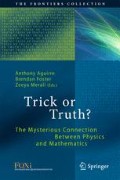Abstract
Imagine there’s only math—physics is nothing more than mathematics, we are self-aware mathematical substructures, and our physical universe is nothing more than a mathematical structure “seen from the inside”: that’s what Max Tegmark’s Mathematical Universe Hypothesis (MUH) proposes. In this paper, I will discuss some consequences of the MUH. While Tegmark claims that the MUH implies the existence of an enormous but finite multiverse (to avoid the measure problem that occurs when you try to calculate probabilities within an infinite ensemble), I will argue that it implies the existence of the largest imaginable multiverse, the Maxiverse, where every imaginable conscious observation is guaranteed to happen. I will attempt to explain why, of all the worlds in the Maxiverse, we happen to live in one that can be understood by physical laws simple enough to be discovered (or, at least, approximated well enough for predictive and technological purposes). I will explore the issue of personal identity in the context of a Maxiverse that contains an infinite number of exact clones of myself, and discuss the Maxiverse Immortality Argument, the idea that I should expect my future subjective experience to be unbounded. Finally, I will consider the question of whether or not the Maxiverse hypothesis can make predictions that can be put to the test.
Access this chapter
Tax calculation will be finalised at checkout
Purchases are for personal use only
References
Tegmark, Max. “Is “the theory of everything” merely the ultimate ensemble theory?”, Annals of Physics 270, 1–51, 1998, http://arxiv.org/pdf/gr-qc/9704009v2.pdf.
Tegmark, Max. Our Mathematical Universe, New York: Alfred A. Knopf, 2014.
Holt, Jim. Why Does The World Exist? London: W.W. Norton, 2012.
Hawking, Stephen. A Brief History of Time. London: Bantam Books, 1988.
Greene, Brian. The Hidden Reality. New York: Knopf, 2011.
Lovejoy, Arthur O. The Great Chain of Being. Cambridge, Massachusetts: Harvard University Press, 1936.
Nozick, Robert. Philosophical Explanations. Cambridge, Massachusetts: Harvard University Press, 1981.
Lewis, David. On the Plurality of Worlds. Blackwell, Oxford, 1986.
Tegmark, Max. “The Mathematical Universe”, Foundations of Physics 38, 101–150, 2008, http://arxiv.org/pdf/0704.0646v2.pdf.
Moravec, Hans. Robot: Mere Machine to Transcendent Mind. Oxford: Oxford University Press, 1999.
Brown, David Jay. Conversations on the Edge of the Apocalypse. New York: Palgrave Macmillan, 2005.
Moravec, Hans. “Simulation, Consciousness, Existence”, Carnegie Mellon University, 1998, http://www.frc.ri.cmu.edu/~hpm/project.archive/general.articles/1998/SimConEx.98.html.
Standish, Russell K. Theory of Nothing. Charleston, S.C.: BookSurge, 2006.
Hut, Piet, Mark Alford and Max Tegmark. “On Math, Matter and Mind”, Foundations of Physics 36, 765–794, 2006, http://arxiv.org/pdf/physics/0510188v2.pdf.
Weinberg, Steven L. Dreams of a Final Theory. New York: Pantheon, 1992.
Author information
Authors and Affiliations
Corresponding author
Editor information
Editors and Affiliations
Rights and permissions
Copyright information
© 2016 Springer International Publishing Switzerland
About this chapter
Cite this chapter
Séguin, M. (2016). My God, It’s Full of Clones: Living in a Mathematical Universe. In: Aguirre, A., Foster, B., Merali, Z. (eds) Trick or Truth?. The Frontiers Collection. Springer, Cham. https://doi.org/10.1007/978-3-319-27495-9_4
Download citation
DOI: https://doi.org/10.1007/978-3-319-27495-9_4
Published:
Publisher Name: Springer, Cham
Print ISBN: 978-3-319-27494-2
Online ISBN: 978-3-319-27495-9
eBook Packages: Physics and AstronomyPhysics and Astronomy (R0)

